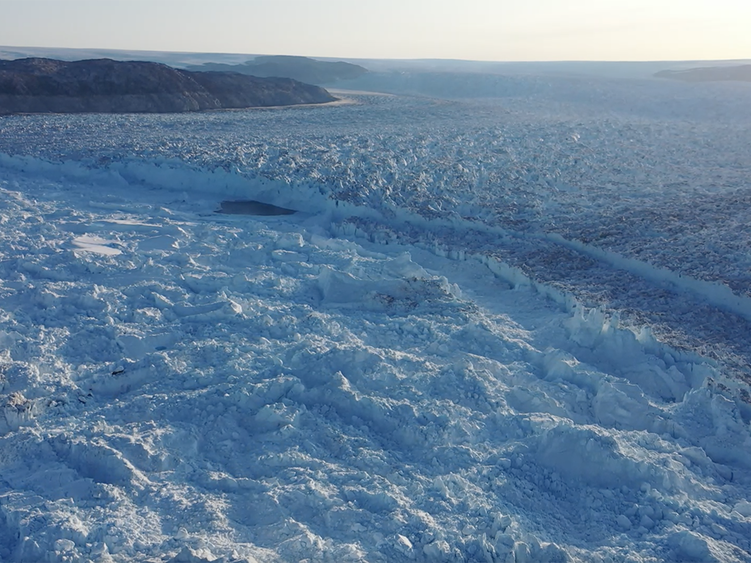
A drone image of Helheim Glacier shows a large plume in front of the glacier's ice cliff and surrounded by ice mélange, 漂浮在海水上的一层厚厚的冰.
宾州大学公园. – Dark patches of open sea that appear in the ice-choked water around Helheim Glacier may reveal new clues about how a rapidly changing Greenland glacier loses ice, according to a Penn State-led team of scientists.
“格陵兰岛正在失去大量的冰, and it drains from the interior of the ice sheet to the ocean through outlet glaciers like Helheim,塞拉·梅尔顿说, a 博士生 in geosciences at Penn State. “Understanding what’s happening at these glaciers is important.”
在温暖时期, enough meltwater drains from underneath Helheim that plumes of buoyant fresh water rise to the surface of the sea in front of the glacier and are visible as patches of open water, 科学家们说.
Tracking these plumes using satellite and time-lapse images, the scientists found when the plumes were visible on the surface that large icebergs stopped breaking away, 或崩解, 来自靠近羽流的冰川.
“我们会看到很多产犊的发生, and then it would stop when the plume was visible and start again after the plume disappeared,梅尔顿说. “And when calving did occur, it happened away from the plume. 他们总是被空间和时间分开.”
Calving at Helheim involves large chunks of ice breaking off from behind the cliff at the front of the glacier, which is up to 300-feet tall in some locations. Helheim once ended in a floating extension called an ice shelf or ice tongue, 比如更大的南极冰川, but that ice has already broken off and melted, 露出悬崖. Calving accounts for about half of the ice loss from the Greenland Ice Sheet and is a significant contributor to sea level rise, 科学家们说.
“塞拉的工作, 包括这篇论文, is an important contribution to the larger effort to understand how iceberg calving really works and what controls its speed, so we can do a better job of projecting what will happen in Greenland, 以及南极洲, and what that will mean for sea-level rise and costal people,理查德·艾利说, Evan Pugh University Professor of Geosciences at Penn State, 他是梅尔顿的顾问,也是这篇论文的合著者.
While the relationship between the plumes and calving was previously observed at Helheim, making direct observations is difficult because of impassable terrane on the glacier and ice in the sea. The scientists conducted a more comprehensive study using high-resolution satellite images and thousands of time-lapse photos from cameras stationed around the glacier from 2011 to 2019.
研究结果, 发表在《365英国上市》上, suggest that changes in hydrology and pressure beneath the glacier are responsible for the relationship between meltwater discharge and calving.
During melt season, water begins pooling in crevasses and forms lakes on the glacier surface. 一些融水流入冰川床, where it begins to fill up cavities and form a network between them, 科学家们说.
“The way a subglacial drainage system evolves is if there’s not very much water under the glacier, 然后是低水压,梅尔顿说. “As the water increases under the glacier, the pressure starts to increase with it.”
As more water flows to the bottom and the water pressure rises, the speed of the glacier’s march toward the sea increases and cracks can form in the ice, 使它更容易产犊, 科学家们说.
但最终在这种压力下, and if enough water is present at the glacier bed, the water can carve channels in the bottom of the ice that direct meltwater into the sea, acting as a kind of relief valve that reduces the water pressure under the glacier ice, 科学家们说. These channels can release enough fresh water for plumes to be visible at the surface of the sea.
“We think this lower pressure configuration inhibits the large calving because the fractures in the bottom of the ice can’t form,梅尔顿说. “So basically, the system that supports the plume existence should suppress the calving.”
Also contributing from Penn State were Sridhar Anandakrishnan, professor of geosciences and Melton’s co-adviser, 和拜伦·帕里泽克, 数学和地球科学教授.
利斯登, 副教授和Michael Shahin, 博士生, 在堪萨斯大学, 亚当·勒温特, 物理科学家, 还有大卫·芬尼根, 遥感主任, at the Cold Regions 研究 and Engineering Laboratory, 也造成.
美国国家科学基金会.K. Natural Environment 研究 Council and Heising-Simons Foundation supported this research.
帕特里夏·克雷格
Marketing and communications, Earth and Mineral Sciences




